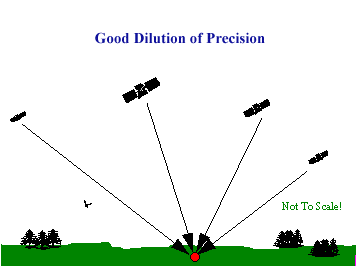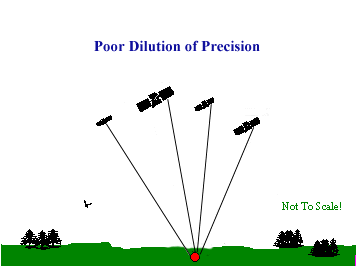
As discussed above, there are several external sources which introduce errors into a GPS position. While the errors discussed above always affect accuracy, another major factor in determining positional accuracy is the alignment, or geometry, of the group of satellites (constellation) from which signals are being received. The geometry of the constellation is evaluated for several factors, all of which fall into the category of Dilution Of Precision, or DOP.
DOP is an indicator of the quality of the geometry of the satellite constellation. Your computed position can vary depending on which satellites you use for the measurement. Different satellite geometries can magnify or lessen the errors in the error budget described above. A greater angle between the satellites lowers the DOP, and provides a better measurement. A higher DOP indicates poor satellite geometry, and an inferior measurement cofiguration.


Some GPS receivers can analyze the positions of the satellites available, based upon the almanac, and choose those satellites with the best geometry in order to make the DOP as low as possible. Another important GPS receiver feature is to be able to ignore or eliminate GPS readings with DOP values that exceed user-defined limits. Other GPS receivers may have the ability to use all of the satellites in view, thus minimizing the DOP as much as possible.
Go back to the previous chapter: The GPS Error Budget
Go on to the next chapter: Using Differential GPS to Increase Accuracy
Return to the Table of Contents
CMTINC.COM |
|||
Tel: (541)752-5456 |
Fax: (541)752-4117 |
||
© Corvallis Microtechnology, Inc. 2000 All Rights Reserved |
|||